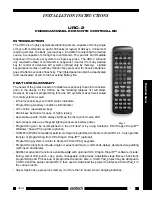
IOM - TRUNNION BALL VALVES, UNIFLOW® BV BT-B9
©COMEV
AL
V
AL
VE SYSTEMS
Technical Dept. Ref. IOM - UNIFLOW BV BT
-B9 - Ed.18/03
Comeval V
alve Systems reserves the right to alter any technical data contained in this Manual without prior notice. Regularly updated data on www
.comeval.es
Page 4
5.2 Assembling additional modules
Optional accessories (limit switches, extensions, etc.) that are supplied with valves must be fitted as required for their
functions as shown in the system plan.
5.3 Requirements at the place of installation
- Aggressive environmental conditions may reduce the life span of the product. Consider special construction/protective
measures in such a case.
- Consider the interaction between the system and the equipment. Foresee elements to absorb vibrations, pipe dilata-
tions, guides, anchoring and proper support according to the weight of the components.
- The system and operation protocol should be conceived in such a way to avoid high velocities and cavitation. Prevent
pulsing flow or water hammers, which are very harmful for valves and the rest of the components.
- Flooding of the product is not recommended.
- Allow enough space for valve installation, operation and maintenance.
- It is recommended to install a proper sized mesh strainer upstream the valve in order to protect seating surfaces from
abrasion or erosion that could lead to seat leakage.
- Planners / construction companies or the owner are responsible for positioning and installing products.
6. – COMMISSIONING & OPERATION
- Ensure valve surface is in good condition and retouch coating protection when needed.
- Once the valve installed, make an initial opening and closing operation to check its proper operability, without additional
tools.
- In case of risk of media freezing inside the valve, take due measures to avoid it.
ATTENTION!
- Before commissioning the valve, check the material, pressure, temperature and other essential parameters. Always
use the product within the scope of intended service and operating duties.
- Before commissioning, make sure previous chapters have been thoroughly followed.
- Regional safety instructions should be adhered to.
- It is essential to flush the pipe system thoroughly to eliminate all the particles and impurities which could remain in
the pipes and particularly welding residue, chips, tool remains, etc. that could damage the equipment during start- up.
Ensure that during cleaning of the pipe system, any chemicals used and temperature are compatible with the valve
construction.
- Temperatures above 50ºC or below 0ºC may cause personnel injuries if valves are touched.
- Leakage of media through valve, between counterflanges or at closing (end of pipeline) may also cause scalding,
health harm, pollution, fire or damage to other parts of the installation depending on the media.
Use suitable protection equipment when approaching the valve, ensure that the corresponding warning signs are
displayed on the valve or surrounding area, and/or isolate the equipment in case of danger.
- Before commissioning a new plant or restarting it after repairs or modification, always ensure that:
- All work has been completed correctly.
- The valve is in the correct position for its function.
- Safety devices/measures have been implemented.
- Valve operation, filling, warming-up and starting-up shall be gradual so as to avoid any inadmissible stress. Check
for tightness in valve connections, body halves parts union, and stem, and retighten crosswise and gradually if neces
-
sary until leakage elimination. When retightenning body halves bolting make sure the valve is in fully open position.
- Packing gland is tightened at factory in a moderate way to pass the pressure tests. After a while before installation,
packing rings experiment a relaxation and some retighten of the gland could be needed during start-up. Over tighte
-
ning will increase operating torque and will reduce life of the packing. Also after several open and close manoeuvres
of the valve the stem gains some play with the packing rings, thus packing tightness should be checked periodically
and retighten gradually when necessary.
ATTENTION!
Welded ends valves:
- Ensure compatibility of ends; clean valve and pipe ends carefully, tack-weld the valve on the pipe in four points
on both end caps, putting trim away to prevent heat exposure when soft parts, if any, could be affected by heat.
Once the welding process is finished, wait until system cools down before inserting the trim back. The installer
should take the necessary precautions to prevent thermal stressing/ overheating the valve during welding process.
ACTUATOR:
- If the valve requires pneumatic, electric or hydraulic actuator, separate actuator Manual shall be also followed.
To avoid unnecessary stress and risk of valve break, consider the weight and the relative position of actuator to
evaluate its support. Make sure that the actuator is suitable for service particular requirements, valve adaptability,
function needed, adequate torque for the valve, adequate speed, need for limit switches, etc. Contact our Techni
-
cal Department for advice. In case of actuator mounted, disconnect the energy supply before starting work.


























